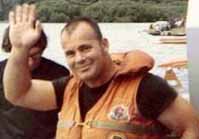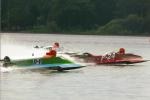Frank,
You could try taking a very coarse file and light running over the surface to remove the bumps. Next, you could put some coarse grit (220?) wet/dry sandpaper on a very flat plate and use a light rotary motion (holding head flat). Next, look at the head and check for flatness. Do the same on the bolt side. Do this for both heads. When things are flat, either scrape or hand sand a small radius on the edge that I've pointed out in the attached photo. The total arc of the radius is something around 90 degrees. It isn't critical, but try to make them all equal. The purpose of the radius is to provide a smooth transition of surfaces (maintain Coanda attachment) for the incoming scavenging fuel charge.
I'm not sure what causes the pitting. It could be some interaction with the painted gasket or simply deterioration of silicon or magnesium in the casting alloy. It goes without saying that if you can, you should test the heads and block for water leaks before assembling.
Frank


 Thanks:
Thanks:  Likes:
Likes: 



 Reply With Quote
Reply With Quote





Bookmarks